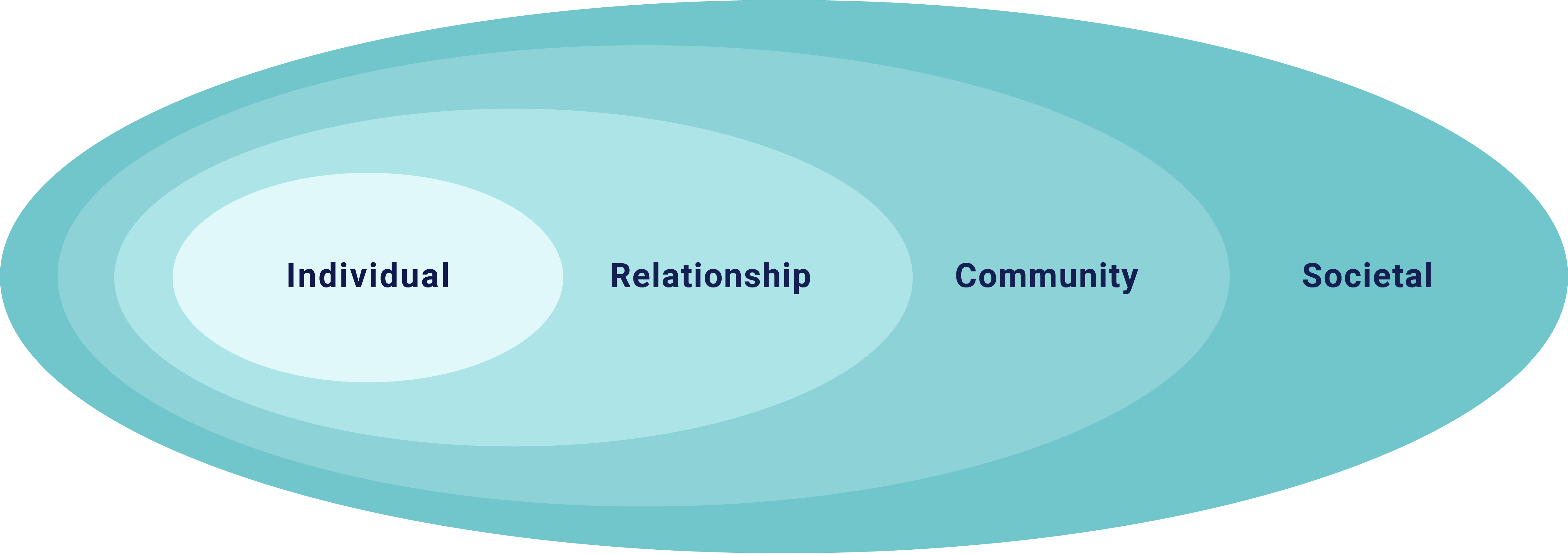

Welcome to the world of violence prevention.
As you explore this world, you will begin a journey to help make lives, relationships, and communities healthier and safer — for everyone.
Scroll to discover and learn how to use knowledge and evidence to create impact in your own community.
This resource explores:
Click on a title above to jump to that subsection.
Download the print friendly PDF for this resource.

Welcome to the world of violence prevention.
As you explore this world, you will begin a journey to help make lives, relationships, and communities healthier and safer — for everyone.
Scroll to discover and learn how to use knowledge and evidence to create impact in your own community.
This resource explores:
Click on a title above to jump to that subsection.
Download the print friendly PDF for this resource.


Public Health Approach
The public health approach is a comprehensive way to help people, organizations, and systems understand the root causes of violence and how to prevent it.
Applying a public health approach to violence prevention means adopting consistent messages about how to prevent violence, promoting use of science-based violence prevention strategies, and collaborating across sectors. This approach also involves engaging members of the communities most impacted by violence.
There are multiple steps in the public health approach, with each one informing the next.
Public Health’s Approach to Violence Prevention in Four Steps
Violence prevention involves these steps to take flight.
Learn more about ways to incorporate community
engagement into prevention efforts in
Violence Prevention in Practice:


Public Health’s Approach to Violence Prevention in Four Steps Mobile
Violence prevention involves these steps to take flight.

01 Define the Problem
This step involves collecting data to find out the “who,” “what,” “where,” “when,” and “how” of violence happening in a given jurisdiction. Data come from a variety of sources — death certificates, medical or coroner reports, hospital records, child welfare records, law enforcement, population-based surveys, and more resources.

02 Identify Risk and Protective Factors
In this step, you explore why some people or communities experience more violence than others. Scientific research reveals what puts people at risk and what protects them. Risk factors are the characteristics of populations or settings that increase the risk for violence. Protective factors buffer against the risk factors and decrease the likelihood of violence. The goal of violence prevention is decrease risk factors and increase protective factors – thereby reducing violence.

03 Develop and Test Prevention Strategies
In this step, prevention strategies are developed using the information gathered in steps 1 and 2. Once prevention strategies are developed, they are rigorously evaluated to see if they prevent violence.

04 Assure Widespread Adoption
In this step effective strategies are disseminated and implemented widely for greater impact. Though this is considered the final step of the public health model, assessments and evaluations continue. Continued evaluation helps ensure all components of a strategy fit within a community and have the desired effect of preventing violence.
Learn more about this approach with Violence Prevention in Practice.
Types of Prevention Efforts
Violence prevention efforts can be divided into two types – Before and After.
PRIMARY PREVENTION
Starts BEFORE violence happens
Strategies that create healthy relationships and environments, reduce risks of violence, and address root causes of violence.
SECONDARY PREVENTION
Starts immediately AFTER violence happens
Services like emergency and medical care address short-term consequences.
TERTIARY PREVENTION
Long-term approaches AFTER violence happens
These approaches address trauma or injuries from experiences of violence and help victims recover physically and emotionally. This can include social support services, community healing services (like support groups, medical support, or case management), and mental health services.

PRIMARY PREVENTION
Starts BEFORE violence happens
Strategies that create healthy relationships and environments, reduce risks of violence, and address root causes of violence.

SECONDARY PREVENTION
Starts immediately AFTER violence happens
Services like emergency and medical care address short-term consequences.

TERTIARY PREVENTION
Long-term approaches AFTER violence happens
These approaches address trauma or injuries from experiences of violence and help victims recover physically and emotionally. This can include social support services, community healing services (like support groups, medical support, or case management), and mental health services.
Types of Prevention Efforts
Violence prevention efforts can be divided into two types – Before and After.

PRIMARY PREVENTION
Starts BEFORE violence happens
Strategies that create healthy relationships and environments, reduce risks of violence, and address root causes of violence.

SECONDARY PREVENTION
Starts immediately AFTER violence happens
Services like emergency and medical care address short-term consequences.

TERTIARY PREVENTION
Long-term approaches AFTER violence happens
These approaches address trauma or injuries from experiences of violence and help victims recover physically and emotionally. This can include social support services, community healing services (like support groups, medical support, or case management), and mental health services.

CDC's Role in Prevention
CDC is committed to preventing violence so that everyone can be safe and healthy. We are widely promoting and using science-based programs, policies, and practices with partners and communities. Our resources can prevent violence before (primary prevention), immediately after (secondary prevention), or during recovery from a violence event (tertiary prevention). Ensuring strategies and approaches can meet communities where they are is important and this is where you can help.
Our collective efforts help CDC support ways to disseminate, implement, and scale-up prevention strategies to create safer communities.
There’s still more work to be done. Violence prevention begins by understanding the basics.

Learn more about violence prevention basics in the Principles of Prevention training.

Learn more about violence prevention basics in the Principles of Prevention training.


Achieving Health Equity
Health equity is the state in which all people have the opportunity to attain their highest level of health regardless of where they live or their personal stories. In contrast, health inequities are preventable, unjust differences in the burden of disease, injury, violence, or opportunities to achieve the highest level of health. Throughout history, some communities have received more access and resources than others. This gap in resources is often impacted by policies implemented at federal, state, and local levels.

Health equity is the state in which all people have the opportunity to attain their highest level of health regardless of where they live or their personal stories. In contrast, health inequities are preventable, unjust differences in the burden of disease, injury, violence, or opportunities to achieve the highest level of health. Throughout history, some communities have received more access and resources than others. This gap in resources is often impacted by policies implemented at federal, state, and local levels.
Addressing Inequities for Health Equity
Systemic social and health inequities, like access to affordable housing, income, healthcare, and educational opportunities, have put some groups at increased risk of violence. Addressing the historical and current conditions that increase the likelihood of violence is essential to achieving health equity.


Inequities Amplify Violence Risks
Many populations experience health inequities that can increase the risk of experiencing violence including people from some racial and ethnic minority groups, people with disabilities, women, people who are LGBTQIA (lesbian, gay, bisexual, transgender, intersex, or asexual), people with limited English proficiency, and other groups.
Intersecting Challenges
The interconnected structures and systems that create inequities among these groups is intersectional – which means that individuals belonging to more than one group may experience overlapping health inequities.


Collaborative Action for Equity
The collective work of community- and faith-based organizations, employers, healthcare systems and providers, public health agencies, and policymakers to use a health equity lens can strengthen efforts to prevent violence.
The Social-Ecological Model
Violence prevention depends on understanding the factors that influence the problem.
The Social-Ecological Model shows the interplay of factors between four levels of society. This range of factors can put people at risk or protect them from experiencing or perpetrating violence.
We must act across all levels to prevent violence.
 Click on the model below to explore the four levels.
Click on the model below to explore the four levels.
Individual
The first level focuses on each of us individually. This level includes personal history and other attributes that may increase the likelihood of experiencing violence. Factors may include education, income, substance use, and history of abuse.
Prevention strategies at this level promote attitudes, beliefs, and behaviors that prevent violence. Examples include conflict resolution and life skills training.
Individual
The first level focuses on each of us individually. This level includes personal history and other attributes that may increase the likelihood of experiencing violence. Factors may include education, income, substance use, and history of abuse.
Prevention strategies at this level promote attitudes, beliefs, and behaviors that prevent violence. Examples include conflict resolution and life skills training.
Relationship
The second level focuses on personal close relationships and interactions with peers, partners, and family members who may influence their behavior and shape their experience.
Prevention strategies here focus on communication, parenting practices, and other bonds and connections. Examples include family-focused prevention programs, mentoring, and peer programs.
Community
The third level identifies characteristics of local settings associated with increased risk for experiencing violence. Settings include neighborhoods, schools, and workplaces.
Prevention strategies at this level impact the social, economic, and physical conditions that may contribute to violence. Community level strategies that strengthen financial security and support neighborhood safety have the potential to prevent violence. Examples include creating safe spaces, improving housing conditions, and increasing employment opportunities.
Societal
The fourth level looks at broad societal factors that include the health, economic, educational, and social policies that help to maintain economic or social inequalities between groups in society.
Prevention strategies at this level impact these societal factors. Examples include strategies to change harmful narratives (like that some individuals or groups accept violence – which ignore the contexts and conditions that increase some groups’ risk for violence), offer economic supports to families, and support equitable education in all stages of life.
Now you know the basics
and are ready to dive deeper.

